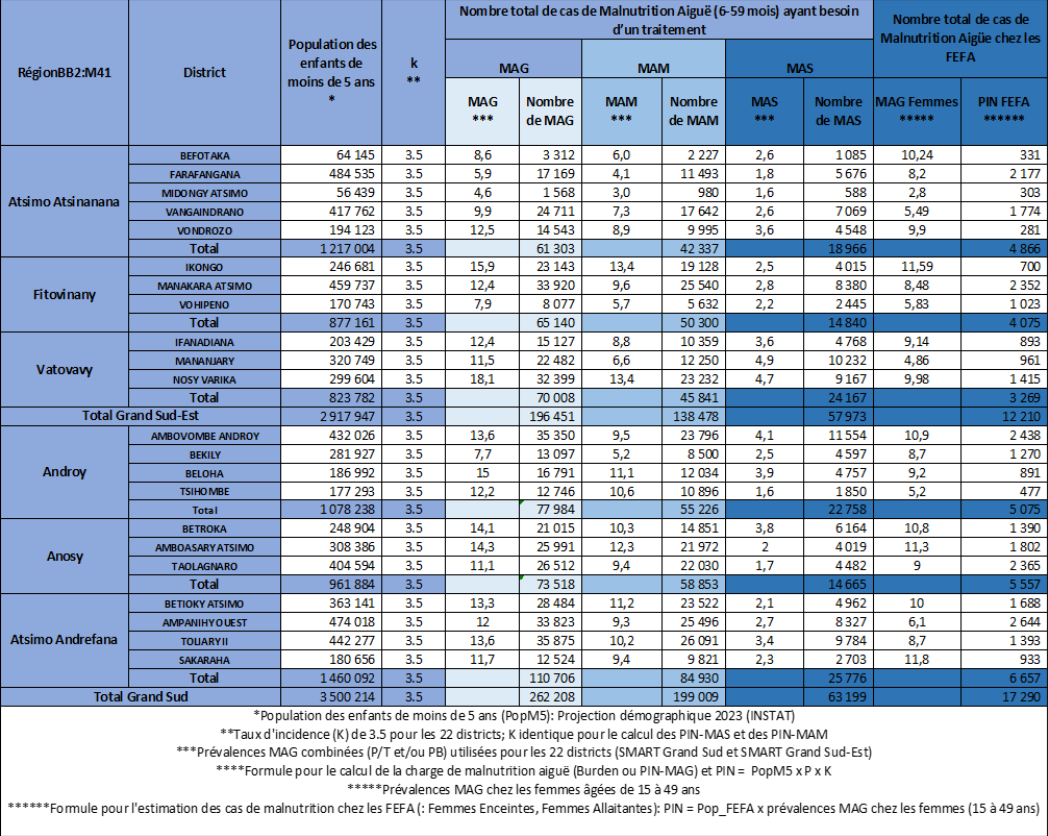18.01.2024
01.10.2023 > 30.09.2024
Map
Projected Map
Other Projections




Key
results
Population
estimates
Recommendations
& next steps
Acute
Malnutrition
In the current period (October 2023 – January 2024), nearly 459,000 children under five are facing/expected to face elevated levels of acute malnutrition. This includes 263,000 cases in Grand Sud and 196,000 cases in Grand Sud-Est.
During the lean period from February to April 2024 (first projection period), the most isolated districts, Nosy Varika and Ikongo are projected to move to IPC AMN Phase 4 (Critical). In the second projection period (May to September 2024), only the Betroka District of Grand Sud is projected to return to IPC AMN Phase 2 (Alert). The districts of Betioky and Ampanihy (Atsimo Andrefana), the four districts of the Androy Region, as well as Amboasary District in Anosy Region will remain in IPC AMN Phase 3 (Serious).
Determining factors of acute malnutrition are low diversity and quantity of food consumption of children, high prevalence of childhood illnesses – particularly malaria – low health services and low rates of coverage of vaccination or vitamin A supplementation.
Country Related Information
Contacts
- 01.09.2024 > 31.08.2025
Madagascar: Acute Food Insecurity Situation for September - December 2024 and Projections for January - April 2025 and May - August 2025 - 01.09.2024 > 31.08.2025
Madagascar: Acute Malnutrition Situation for September - December 2024 and Projections for January - April 2025 and May - August 2025 - 01.05.2024 > 30.04.2025
Madagascar: Acute Food Insecurity Situation for May - September 2024 and Projections for October - December 2024 and January - April 2025 - 01.10.2023 > 30.09.2024
Madagascar: Acute Food Insecurity Situation for October 2023 - January 2024 and Projections for February - April 2024 and May - September 2024 - 01.07.2023 > 30.04.2024
Madagascar: Acute Food Insecurity Situation for July - September 2023 and Projections for October - December 2023 and January - April 2024 - 01.06.2023 > 30.04.2024
Madagascar: Acute Malnutrition Situation for June - September 2023 and Projections for October - December 2023 and January - April 2024 - 01.11.2022 > 31.10.2023
Madagascar: Acute Food Insecurity Situation for November 2022 to March 2023 and Projections for April to July 2023 and August to October 2023 - 01.05.2022 > 30.04.2023
Madagascar: Acute Malnutrition Situation for May to September 2022 and Projection for October to December 2022 and January to April 2023 - 01.08.2022 > 31.03.2023
Madagascar: Acute Food Insecurity Situation for August to October 2022 and Projection for November 2022 to March 2023 - 30.05.2022 > 31.03.2023
Madagascar: Acute Food Insecurity Situation for April to August 2022 and Projections for September to November 2022 and December to March 2023 - 01.11.2021 > 31.08.2022
Madagascar: Acute Food Insecurity Situation November - December 2021 and Projections for January - April 2022 and May - August 2022 - 01.11.2021 > 31.08.2021
Madagascar: Acute Malnutrition Situation November - December 2021 and Projections for January - April 2022 and May - August 2022 - 01.04.2021 > 30.04.2022
Madagascar: Acute Food Insecurity April - September 2021 and Projection for October - December 2021 - 01.05.2021 > 30.04.2022
Madagascar: Acute Malnutrition Situation May - August 2021 and Projections for September - December 2021 and January - April 2022 - 01.10.2020 > 30.04.2021
Madagascar: Acute Food Insecurity for October - December 2020 and Projection for January - April 2021 - 01.10.2020 > 30.04.2021
Madagascar: Acute Malnutrition Situation October - December 2020 and Projection January - April 2021 - 01.02.2020 > 31.12.2020
Madagascar: Acute Malnutrition Situation February - April 2020 and Projections for May - August 2020 and September - December 2020 - 01.04.2020 > 31.07.2020
Madagascar: Acute Food Insecurity Projection Update April - July 2020 - 01.07.2019 > 30.06.2020
Madagascar: Acute Food Insecurity Situation July - October 2019 and Projections for November 2019 - March 2020 and April - June 2020 - 01.06.2019 > 31.12.2019
Madagascar: Acute Food Insecurity June - July 2019 and Projection for August - December 2019 - 01.08.2018 > 31.03.2019
Madagascar: Acute Food Insecurity Situation August - October 2018 and Projection for November 2018 – March 2019 - 01.03.2018 > 30.09.2018
Madagascar: Acute Food Insecurity Situation March-June 2018 and Projection for July-September 2018 - 01.08.2017 > 31.03.2018
Madagascar: Acute Food Insecurity Situation August-October 2017 and Projection for November 2017 - March 2018 - 01.03.2017 > 30.09.2017
Madagascar: Acute Food Insecurity Situation March - May 2017 and Projection for June - September 2017 - 01.03.2017 > 30.09.2017
Madagascar: Acute Malnutrition Situation March - May 2017 and Projection for June - September 2017 (Grand Sud) - 26.11.2016 > 31.03.2017
Madagascar: Acute Malnutrition Situation in Grand Sud for December 2016 and Projection for January-March 2017 - 01.10.2016 > 31.03.2017
Madagascar: Acute Food Insecurity Situation in Grand Sud for October 2016 - December 2016 and Projection for January - March 2017
- 04.07.2025 > 25.07.2025
Madagascar: Acute Food Insecurity and Malnutrition Analyses - 02.10.2024 > 05.10.2024
Madagascar: Acute Malnutrition Analysis - 15.06.2024 > 21.06.2024
Madagascar: Acute Food Insecurity Analysis - 09.12.2023 > 17.12.2023
Madagascar: Acute Food Insecurity and Acute Malnutrition Projection Update
Join our mailing list


